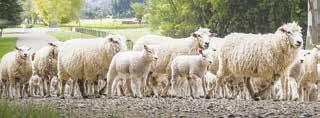
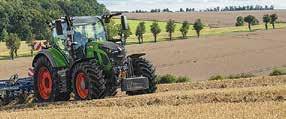
MACHINERY & PRODUCTS
Fendt 600 Vario series compact, easy to work with. PAGE 15




Fendt 600 Vario series compact, easy to work with. PAGE 15

SUDESH KISSUN
THE DEBATE around New Zealand’s future in the Paris Agreement is heating up.
While some farmers are pushing for NZ to withdraw from the climate change pact, industry-good bodies DairyNZ and Beef+Lamb NZ warn against doing that.
Federated Farmers is also grappling with the issue. As this edition of Rural News went to press, the Feds annual meeting in Christchurch was deliberating on several remits from some provinces to withdraw from the Paris
Agreement, which NZ signed in 2016.
The Government has no plans to withdraw. At the Primary Industries Summit in Christchurch last week, Agriculture Minister Todd McClay said that leaving the Paris Agreement would be madness.
He warned that other countries would use that to block our exports and clear our products from their supermarket shelves.
“There would be consequences, whether you believe in climate change or not, because the world does not owe New Zealand a living,” says McClay.
Methane Science Accord spokesman Owen Jennings says the Minister
of Agriculture and Trade has a strange idea of ‘madness’.
“The claim that the world’s supermarkets would refuse to stock New Zealand’s healthy food if we left the Paris Agreement is a much better definition of ‘madness’ than his idea that leaving would have dire consequences,” he told Rural News
“Why on Earth would they refuse our superior quality food, that has the lowest carbon footprint of any exported produce, in exchange for environmentally-inferior goods produced in crammed, smelly barns and over-crowded feedlots often shot full of hormones and antibiotics?”
He says McClay ought to be asking all food exporters for their comment on leaving the Paris Agreement.
“He might find his claim about an adverse reaction is not shared by all of them,” says Jennings.
DairyNZ chair Tracy Brown says exiting the Paris Agreement would not be in dairy farmers’ interests as they believe it would affect our credibility with customers.
Dairy drives the export-led NZ economy, which is underpinned by trade agreements that specify adherence to the Paris Agreement, she told Rural News.
“A lot of work goes into negotiating

trade agreements, with modern ones including environmental language and all coming up for renegotiation at some stage, so we need to be well placed on this. We would want to see the Agreement implemented as intended: without limiting food production and export revenues.”
Beef+Lamb NZ chair Kate Acland told Rural News that they were “very unhappy” about the Government’s revised international commitment that they made earlier this year.
“However, there are real trade risks if New Zealand withdraws from Paris – it would not just be symbolic,” says Acland.












NEWS 1-10
MANAGEMENT 11
HOUND, EDNA 12
CONTACTS 12
OPINION 12-13
ANIMAL HEALTH 14
MACHINERY AND PRODUCTS 15-18
RURAL TRADER 19
SUDESH KISSUN sudeshk@ruralnews.co.nz
WE’RE WORKING through it, and we’ll get to it.
That’s Agriculture Minister Todd McClay’s response to repeated calls from Federated Farmers to allow young farmers to use their KiwiSaver funds to buy their first farm, flock or herd.
HEAD OFFICE
Lower Ground Floor, 29 Northcroft Street, Takapuna, Auckland 0622
Phone: 09-307 0399
Fax: 09-307 0122
POSTAL ADDRESS
PO Box 331100, Takapuna, Auckland 0740
Published by: Rural News Group
Printed by: Inkwise NZ Ltd
CONTACTS
Editorial: editor@ruralnews.co.nz
Advertising material: davef@ruralnews.co.nz
Rural News online: www.ruralnews.co.nz
Subscriptions: subsrndn@ruralnews.co.nz
An online Federated Farmers petition calling on the Government to make urgent changes to KiwiSaver rules remains active. And the farmer lobby has been reminding the Government that on the campaign trail of the 2023 election, McClay stood up in front of young farmers in Morrinsville and made a promise that he would make it happen in the first term of the new Government.
McClay, who spoke at the Primary Industries Summit in Christchurch last week, urged Federated Farmers to be patient.
“We’re working through it. We’ll get

to it, I guess,” he told Rural News
“If that’s all they’re complaining about, it’s because all the other things they campaigned on have been done, and farmers are in a much better place,” he says.
“I suppose if all we’d done is KiwiSaver and not fixed the freshwater
rules, or the RMA, or all the things that were harming farmers around climate change from the Labour government, there would be a much longer list.
“But we’re working through that now. We’ve just got to get it right and make sure it’s fair to all New Zealanders, but it was a commitment we made, and we’ve still got a year and a half to go before the election.”
Finance Minister Nicola Willis signalled at Fieldays that the Government may change the rules to allow farmers to withdraw their KiwiSaver to buy their first farm.
However, the Government has poured cold water on a Feds request to allow withdrawals so that sharemilkers could buy their first herd.
The Government is also facing criticism from some KiwiSaver fund managers, who warn that allowing farmers to use their KiwiSaver funds to buy a first farm or herd could be problematic.
Sam Stubbs, co-founder of KiwiSaver fund, Simplicity says this
A MAJOR milestone on New Zealand’s unique journey to eradicate Mycoplasma bovis could come before the end of this year.
A provincial declaration that the country is free of Mycoplasma bovis may be made in either October or November, says Ministry for Primary Industries (MPI) director general Ray Smith. Speaking at the Primary Industries NZ Summit in Christchurch last week, he says the eradication of M. bovis has been “a real success story”.
“So, if you were involved in that in any way, you have our deepest understanding of how difficult it is to have someone turn up on your farm one

day and say, ‘actually putting a notice on it, you’re going to stop what you’re doing until we clean this up’,” says Smith.
“About 300 farmers had that experience. But we haven’t had this disease turn up for two years now.”
Smith says NZ has achieved something the rest of the world said couldn’t be done.
“We spent $750 million getting to this point, industry and government both contributing to solving that problem. We’re (23:29) almost there.
“We’ll see, if we get through this spring, which is the risky period, by October, November, we’ll declare
provisional freedom of absence of Mycoplasma bolus in New Zealand. And that’s a great thing. To not have to live with lameness, aborted calves and mastitis related problems in our animals is a good thing to have achieved.”
The M. bovis programme, jointly funded by the Government and farmers, started in 2018 and should finish by 2018.
Under the programme, we need to pass through three phases to provide confidence that M. bovis is absent in cattle herd – delimiting phase to identify and remove cases of infection and provisional absence — focussing

could weaken KiwiSaver’s core purpose as a retirement savings scheme and offers only marginal benefits to a small group of people, while impacting millions of members.
Stubbs believes the change, if approved by the Government, would have limited impact on farmers.
“KiwiSaver isn’t well-suited for self-employed individuals, including many farmers, as it lacks employer contributions and government subsidies have been whittled away over time,” he says.
Feds outgoing dairy chair Richard McIntyre says KiwiSaver is designed to help New Zealanders grow their wealth to financially support them in their retirement years, but farmers tend to take a different pathway to financial security.
“For a young dairy farmer that pathway is to get into sharemilking early, build up equity and a herd, and to eventually buy their own farm. It’s a well walked progression pathway,” he says.
on monitoring the cattle population through background surveillance. There needs to be two consecutive clear springs and two consecutive clear autumn calving periods to build up a good level of confidence that M. bovis is no longer present.
The third phase is confidence of absence. In this phase, background surveillance continues until the industry achieves a very high level of confidence that M. bovis is eradicated. This phase is expected to run for two years. The confidence of absence phase ends with a statement of absence and M. bovis is then considered exotic. – Sudesh Kissun

Jobs for Nature programme which ran out of funding in 2024.
FUNDING IS proving crucial for predator control despite a broken model reliant on the goodwill of volunteers.
That’s according to Jessi Morgan, chief executive of Predator Free New Zealand. She says many volunteers are working with the organisation “out of love for nature or the protection of their land”.
“We commissioned research into the predator free funding system last year, which revealed some changes to the system that could make a real difference,” Morgan told Rural News
That report suggested there was a growing gap between the availability of support and demand. That gap was accompanied by the end of the
Subsequently, Predator Free 2050 Ltd, the Crown-owned company set up by then-Prime Minister John Key in 2016, was disestablished as part of Budget 2025.
The Predator Free New Zealand report suggested that without improved funding, the organisation could lose both the ecological and social gains already made.
Morgan says those improvements would include making funding grants easier to access and less burdensome.
She also says morelong-term funding is required “so predator free groups can have the stability to plan for the future”.
Morgan says that introduced predators are most associated with the

destruction they cause to New Zealand’s native wildlife.
“But farmers, too, bear the brunt of these mammals,” she says. “They

cause many problems on farms, costing farmers time and money to fix. Rats, possums, stoats, ferrets, weasels, hedgehogs and feral cats can eat
crops, spread diseases, damage equipment, and eat native planting.”
She says that one of the biggest issues farmers have when it comes to
predator control is time.
She says it can be difficult for farmers to fit predator control into an already full schedule but upfront research, planning, trapping choices, and working with neighbours or a catchment group can make a difference.
“There is heaps of smart advice about how to work predator control into day-to-day onfarm work, for example, pulsing bait or setting possum traps at their most active times of year.”
Morgan says that, based on anecdotal evidence, it looks like the number of predators onfarm is increasing, adding that the organisation regularly hears tales of problematic numbers of feral cats, possums, and rats.
“Many factors contribute to this, including
a reduction in the OSPRI TB possum programme, climate change, and milder winters resulting in better breeding conditions. Farmers are struggling to keep on top of predators as their numbers surge,” she says.
She says there are many ways to get involved in predator control.
“Whether you live in a city, town, lifestyle block or farm, we’ve got something to help you get involved – practical advice, info on community groups in your area, or even bird memes.
“Tell us your stories and challenges. Your experience helps us look into useful advice, connect you with experts and spotlight great work happening around the country,” Morgan concludes.
@rural_news
facebook.com/ruralnews




A BRILLIANT result and great news for growers and regional economies.
That’s how horticulture sector leaders are describing the news that sector exports for the year ended June 30 will reach $8.4 billion – an increase of 19% on last year and is forecast to hit close to $10 billion in 2029.
Speaking at Primary Industries NZ summit in Christchurch last week, Associate Agriculture Minister Nicola Grigg noted that it was a brilliant result for a sector “that had come through a dark time”.
“The figures are phenomenal, and few economies can match numbers like that,” she says.
“Our farmers, growers and processors deserve a big pat on the back.”
The recovery by apple and pear growers, especially in Hawke’s Bay and Gisborne, is worth noting. These areas faced huge losses from floods and cyclones but stabilised over the past yearseeing higher yield and higher profitability and recording higher export volumes.
Hort NZ chief executive Kate Scott says that this latest forecast in the Ministry for Primary Industries (MPI) outlook for the sector reinforces the growing impor-

tance of horticulture to the national economy. She says the horticulture sector continues to go from strength to strength and adds that growers,
exporters and supply chain partners deserve huge credit for their resilience and commitment to delivering world-class products from NZ.
“However, it is important to remember that greater export revenue for the horticulture sector does not necessarily translate into greater
MEAT AND wool earnings for the year to the end of June are expected to hit $12.3 billion – almost a billion more than they were a year ago and modest increases are expected over the coming four years.
MPI’s report says tighter global beef and lamb production is lifting prices and offsetting some of the challenges being encountered in the Chinese market.
It adds that the higher prices NZ is obtaining for beef and lamb, along with the weaker NZD against the USD is strengthening export prices and farm gate returns.
The report predicts that the average farmgate profit before tax for all classes of sheep and beef farms for 2024/25 will be $106,000, an 89% increase on last year.
There is a suggestion in the report that this
could lead to farmers increasing expenditure on fertiliser and repairs and maintenance as they catch up on deferred expenditure.
MIA chief executive Sirma Karapeeva says the improved forecast highlights the sector’s importance to the NZ economy. She says they are expecting an uplift in key export prices, driven by reduced global production of beef and lamb and continued strong international demand for red meat.
Karapeeva says this year there’s been growth in value to most of our major markets, notably demand for our beef and sheepmeat in the US, a significant increase in sheepmeat volumes to the European Union, and a recovery in exports to China.


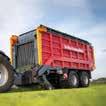
profitability for growers because they are facing increased costs of production, so we need to ensure that value is also returned to growers. The ability to grow the sector into the future is directly related to the profitability of horticulture businesses,” she says.
Scott says this reinforces the need for policy settings that enable the sector to grow nutritious, affordable fruit and vegetables.
The huge jump in hort exports is led by a billiondollar leap in the value of kiwifruit exports which soared from $2.8 billion a year ago to $3.8 billion this year – a massive 36% increase – and it doesn’t
stop there with kiwifruit exports predicted to be worth $4.3 billion by 2029.
Also playing a significant hand in the rise and rise of horticulture is the contribution of apples and pears. They broke the billion-dollar mark for the first time at $1.1 billion –up 18%, with further rises predicted though to 2029.
Fresh and processed vegetables and ‘other products’, which include avocados, cherries and blueberries also had a good year.
Forecast revenue for avocado exports is expected to jump192% to $108 million, cherries 35% to $124m and squash 7% to $60 million.
Grigg says the sector is poised for impressive growth. She says the 19% growth rate for 2025 is phenomenal – the fastest of any agricultural sector – reflecting the dedication and resilience of our growers and exporters.
Grigg says looking ahead, the sector’s continued hard work is expected to drive that even higher reflecting the vital role horticulture plays in NZ’s economy and global trade.
“These strong results are thanks to the dedication and hard work of our fruit and veggie growers - and the Government is fully committed to backing their ongoing success.”
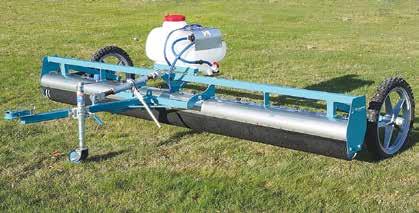


Award winner Bridie Virbickas.
THERE ARE opportunities outside the farmgate for young farmers to further develop their skills, says 2025 Primary Industries Emerging Leader
Contract milking 800 cows at Otakiri, near Whakatane, Virbickas is making a strong mark beyond the farmgate.
She joined Federated Farmers four years
ago and chairs its Bay of Plenty sharefarmers section.
In the role, she supports fellow farmers through advocacy, dispute resolution, and practical workshops.
She’s also a found-
ing trustee of AgRecovery, helping reduce farm waste nationwide, and leads on-farm restoration projects with schools and councils – demonstrating her commitment to both sustainability and community.
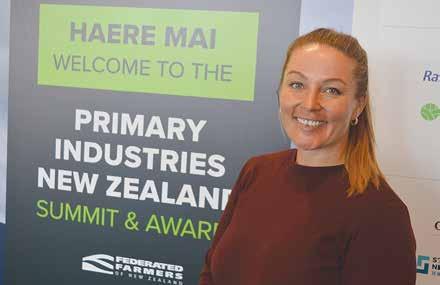

Two years ago, she also served as DairyNZ associate director for 12 months and has completed the Fonterra Governance Development programme.
Virbickas told Rural News that she has been lucky to have worked with great people at Feds and on the DairyNZ board.
“It has been a great learning experience,” she says.
Virbickas adds that
farming in rural areas can be a challenge.
“It can get isolated, so doing voluntary work outside the farmgate and developing your skills through programs can be a big help.”
She says winning the award was “totally unexpected”.
“It’s great to be recognised by my peers: I’m humbled that they considered me worthy of the award.”
THE RURAL Hero Award was awarded this year to former Federated Farmers national board member Chris Allen, who died in an accident on his Ashburton farm late last year.
It’s been said that every New Zealand farming family is in his debt for his years of championing rural causes. The judges acknowledged Allen’s “collaborative nature, persistence and practicality”, which meant as a Federated Farmers leader his advocacy on freshwater, environmental and biodiversity issues was compelling and effective.
“A top farmer in his own right, he led with humour and knowledge.”
Southland farmer and NZ Pork chair Eric Roy was presented with the Outstanding Contribution to Primary Industries Award.
Roy’s production, leadership, advocacy and political service to primary industries and rural communities in New Zealand and the wider Pacific spans nearly 60 years.
His work for Young Farmers culminated in his election as world president, and the six-term Member of Parliament has also excelled in roles with Federated Farmers, Pāmu, the Meat & Wool Board and a host of community and charity initiatives.
“Few can match his contribution. Eric Roy is a truly exceptional New Zealander,” the judging panel said.


NEW ZEALAND must continue to educate Chinese consumers about the unique qualities of its red meat products and how they differ from competitors, says Silver Fern Farms chief executive Dan Boulton.
He was member of a large party of businesspeople who went on Prime Minister Christopher Luxon’s recent trip to China. The visit was politically important, with much effort spent highlighting education, tourism and primary exports.
Boulton told Rural News this was his fourth
trip to China this year. He says business there is all about relationships – boots on the ground – and the trip was very successful for all the 29 businesses that made the trip.
“Having the Prime Minister there engaging directly with your customers is pretty powerful and that impact was not lost on our market up there,” he says.
Boulton says China is a big meat-eating country and they especially like beef – demand that NZ has benefited from. But he notes, so have others such as South America and Australia. He says South America exports as much meat into China

in a week as NZ does in a year. He also notes that NZ exports to China amount to just one third of one percent of trade with China.
A major feature of the
trip was the staging of a large event in Shanghai, to leave no doubt in the minds of the Chinese that NZ meat is sustainably raised, grass fed and of the highest quality. Luxon
presided over the ‘Red Meat Country of Origin’ event which is part of the wide Taste Pure Nature concept.
Boulton says it was good to be able to have their customers along at this event which was well received by the Chinese and attracted good media coverage.
“Focused and wellresourced Country of Origin programmes do make a difference in a crowded marketplace and are a sensible way to achieve some critical scale that will help position NZ red meat as a premium in market,” he says.
Boulton says SFF was able to host one of their




Purchase a 5L of TURBO® or BOSS® Pour-On and receive a NZ Made Far South
key customers in Guangzhou and, again, having the Prime Minister there showed the power of NZ’s commitment. He says the functions at the NZ Embassy in Beijing were also very successful. He says being able to invite key customers to meet the Prime Minister and having the Maori kapa haka group there did much to demonstrate the strong cultural ties China and NZ enjoy.
Overall, Boulton says there is more confidence in the Chinese market. He says they are short of meat and want more of NZ’s fantastic red meat. He says for our farmers, there is every reason to feel more confident with
farmgate returns up over the last five months.
But he warns that the global markets continue to be volatile and are facing additional uncertainty because of the latest Middle East war. Boulton says ensuring that there are no disruptions in the Strait of Hormuz is critical because it’s the gateway to the key port of Dubai and other premium markets in the Gulf states.
“We just have to be innovative and resilient and work around any difficulties,” he says.
• For details about Silver Fern Farms’ Pasture to Plate Farmer Conference, see page 20.
Using DMI-Sorb™ rain resistant technology, TURBO® and BOSS® Pour On are products you can depend on in New Zealand’s unpredictable weather. Come rain or shine, enjoy the ultimate parasite coverage.

JULIA JONES
ACROSS RURAL conversations, we’re hearing the same tune: crisis. From “Save Our Sheep” to doom-laden messages around methane targets and global agreements like the Paris Accord, these narratives often share a common thread— high emotion, a single villain, and one extreme solution: get out, or go under.
But these aren’t solution-focused conversations; they’re no-hope narratives. Constantly anchoring to despair drains resilience, stifles innovation, damages mental wellbeing, and risks significant economic harm.
Exiting the Paris Accord would create significant economic risk for New Zealand. With over 80% of our exports
going to countries that require mandatory climate reporting — most of them signatories to the Paris Accord — we jeopardise crucial market access and preferential treatment (Chapman Tripp, April 2024). While we might retain some customers, we would likely become fallback suppliers, paid far less for our products. Considering our food and fibre exports alone are forecast to reach $56.9 billion by June 2025 (MPI SOPI, June 2025), risking these revenues is economically reckless.
We’ve already felt the impact of uncontrollable events; extreme weather wiped out $1.2 billion in export earnings in 2023 (MBIE, November 2023). Given these existing challenges, why would we deliberately endanger future revenue?
We all want thriving rural communities, robust businesses, and options for future generations. Choosing a path that sabotages these economic channels isn’t reclaiming control—it undermines the prosperity and security of the very communities we aim to protect.
Even the Prime Minister has been clear: New Zealand’s climate commitments must support — not sabotage — trade access. In today’s volatile world, credibility, alignment, and stability matter more than ever.
It’s not just the economy taking a hit—it’s people. Constantly hearing we’re in crisis takes a toll on us as humans. There’s a reason behind how we respond subconsciously: it’s about protecting our basic needs. We all need to feel valued

(status), have some idea of what’s ahead (certainty), make our own decisions (autonomy), feel connected (relatedness), and be treated fairly (fairness). When these get shaken up, we naturally pull back, lose motivation, and disengage—often without even realising it. It’s not about weakness; it’s just how



to the sense of injustice. When these fundamental needs are threatened, people disengage and shut down. The very people we need to lean into solutions—innovators, practical thinkers, and risk-takers—are left feeling exhausted and disheartened.
erty before it even gets a chance to walk through the gate
we’re wired.
There’s a sense that decisions are being imposed on them rather than made collaboratively. Rural communities also often feel isolated from urban conversations, reinforcing feelings of disconnection. Finally, there’s a growing perception that farmers are unfairly targeted, adding
You’ve likely felt one or more of these pressures, that’s not weakness, it’s just being human. Feeding despair keeps us stuck in survival mode instead of enabling clear-headed thinking, calm decision-making and clicking into growth mode.
The world is shifting fast, its often scary, frustrating, and messy. Yet, fueling no-hope narratives wastes energy and pushes solutions away. Sometimes, we’re so worn down we chase progress off the prop
How we think shapes how we feel. Crisis mode breeds frustration, fear, and fatigue. Choosing curiosity over hasty reaction creates space to act differently moving from outrage to understanding, from hopelessness to possibility. It’s not about suppressing emotion but changing the story that fuels it.
A Simple Ask—before cranking up outrage, turn up curiosity. Pause to ask why something is happening instead of reacting immediately.
Understanding might not always change outcomes but it absolutely changes how we show up: in conversations, in decisions, and in leadership.
• Julia Jones is general manager of Agri-Women’s Development Trust











Ovitage.
A NEW Zealand company is redefining the global collagen game by turning New Zealand sheepskin into a world-class health product.
Christchurch-based Tertiary Extracts Otautahi (TEO) claims Ovitage, a branded ingredient it makes from sheepskin – a waste product – is the world’s “most complete collagen”.
TEO sells Ovitage to companies making finished products in the supplement and functional food area. TEO also has its consumer product, the Everee Women range of collagen supplements that contain
The company says this addresses health needs of women and different stages of their life and has had a strong consumer response, with a community building around the technology and the much-needed discussion around women’s health.
TEO founder and chief science officer, Dr Rob Kelly, says people need more protein as they age and Ovitage helps boost protein intake in convenient and easily digestible format.
“But much more than that, it provides high quality nutrition because it is higher in particular amino acids than conventional collagen,” he told

“These amino acids support healthy metabolism in different areas, such as high cystine for hair and skin health, high
tyrosine and glutamic acid for brain health and performance. We need more protein but we need the right sort of protein, which is what Ovitage
provides.”
TEO has spent a decade exporting value added New Zealand biologicals to the US nutritional and functional foods market.
Kelly says that during this time, they witnessed the massive growth in demand for collagen and were surprised and disappointed to see that New Zealand was not participating significantly in the collagen opportunity, despite being among the best in the world at raising grass fed, ethically sourced and traceable animals that could provide the raw material.
“We then found that sheepskin was an abundant waste material produced by the New
Zealand red meat sector and saw an opportunity to conduct some solid research and science to extract novel and valuable proteins from this and prove out their benefits, in the poorly served women’s health market.
“This development enabled us to address some of the global demand for differentiated collagen while also addressing unmet need in women’s health.”
Manufacturing commenced in mid-2024 and the first consumer product on world menopause day in October 2024. The first branded ingredients to the US market were exported in November 2024.
Kelly would not go
into monetary details of value extracted from sheepskin.
He adds that specifics are confidential, but as a waste material sheepskin has very low, or even negative value due to potentially incurring a disposal cost.
“We extract and purify the valuable proteins from this material and so create value from this waste.
“We are starting to see export returns by selling this into nutritional markets overseas, maximising the value that our primary sector can return for country and ensuring we make the most of every part of the animal.”
@rural_news
facebook.com/ruralnews


PETER BURKE
A UNIQUE discovery by a Palmerston North science company, Biolumic, looks set to revolutionise the value and potential of ryegrass and the secret is the application of ultraviolet (UV) light.
The process involves treating ryegrass seeds with varying degrees or recipes of UV light which sends ‘messages’ to the seed to react in certain ways. The outcome, according to the company’s founder and chief science officer Dr Jason

Wargent, is increased yields, increased metabolised energy (ME) and increased lipids to supress methane.
Wargent, originally from England and who did his PhD in plant photobiology, has always specialised in the effects of UV light on plants. He says his reason for doing this back in the early 2000s was concern about the thinning ozone layer and what effect increased natural UV would have on plants. In the end he says that threat largely went away, but he and a small






“One of the things that struck me was that over millions of years, seeding plants had naturally adapted to UV light.”
group of researchers looked further into the effects of UV on plants.
Fast forward to 2010, Wargent took up an academic position in the College of Agriculture and the Environment at Massey University where he continued his work in his specialist field.
“One of the things that struck me was that over millions of years, seeding plants had naturally adapted to UV light,” he told Rural News
“Long before humans arrived, their seeds simply dropped on the ground and life continued apparently unaffected by UV light. It was things like drought that killed plants – not UV light,” he says.
Given the plants
were getting ‘messages’ from natural UV light, the thought was that we could artificially mimic what nature was doing and send ‘new messages’ to plants by utilising UV light treatments.
He says they initially did this successfully on plants in the nursery by sweeping across them various UV light treatments. This was not just about yield, but about consistency of a crop to suit customers. But there was more to come with the focus turning to seeds – the breakthrough moment for Biolumic. Nobody else in the world had attempted to use UV light on seeds to improve the performance and characteristics of a crop.
IN A relatively small and inconspicuous laboratory near Palmerston North, Dr Jason Wargent and his team of scientists are doing what some have said, and are still saying – is impossible. Yet, they are being proved wrong, because it is already working in the USA with corn and soy. Now the focus is ryegrass and it’s based on what nature already does.
“We know that all crop plant species have certain detection equipment, such as certain proteins and so on, that can detect UV light and that’s been going on for millions of years, and what we have been able to do is piggyback off that evolutionary adaptation,” he says.
To that end, ryegrass seeds are being run through a machine and given different types of light treatments to produce different traits. Wargent calls them light recipes. It’s not just about the time the seeds are exposed to UV light, it’s about the density and other factors of the UV light treatment. In the initial stage of the research, the exposure time could be up to 24 hours, which was “uncommercial”. But now the process has been refined, and it is down to minutes or seconds.
Seeds that have been treated in this way are now being grown as plants in Biolumic’s laboratory and the results are excellent. And for the record, no further applications of UV are involved in this process.
The initial focus on the seed treatments so far, as stated earlier, is on yield, ME and methane suppression by increasing lipid content. They are also looking at the opportunity of heritability of the traits in the ‘parent’ seeds and plants and already the results from the laboratory suggest this is feasible.
The real test will come with the field trials which Wargent says will start next year. This will also be an opportunity to look at such things as drought resistance and overall persistence. He says these trials will take place in 2026 and 2027 and, by then, they hope to have product for commercial release. All being well at that point, Biolumic will come to a licensing arrangement with seed companies to produce the modified seeds in commercial quantities, at an affordable price for farmers that reflects the benefits of these new seeds.
“Our goal is to deliver seed trait packages to farmers that will potentially allow them to put less nutrients into the ground, produce more efficient plants and roots and provide an opportunity to reduce nitrous oxide and methane emissions, while at the same time increasing crop yield and ME that will in turn could increase milk solids, so everyone is a winner,” he says.
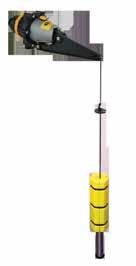



ing cows, 50 weaner heifers, 4000 ewes and 250 weaner red deer.
SOUTH ISLAND sheep and beef farmers Matt and Kristin Churchward say using artificial intelligence (AI) to spread fertiliser on their sprawling 630ha farm is a game changer for their business.
Their farm near Taihape is one of 18 farms involved in a pilot for Ravensdown’s HawkEye Pro – a software that uses AI, decades of soil data, and cutting-edge mapping software to create detailed maps of soil nutrient levels across an entire farm without the need for a fresh round of soil testing.
The pilot began on the Churchward Trading Co Ltd farm in April. The farm is mostly hilly country with some flat areas, and run 130 breed-
Kristin says fertiliser is normally applied using “a blanket approach” to some areas of the farm while application to other areas was varied.
She says in May this year, Aerowork, using HawkEyePro, applied superphosphate in May 2025. The aerial variable rate map showed seven rates, marked in different colours, applied across the farm.
“There were areas in the map where there is no variable rate colour, showing exclusion zones to prevent wastage and a more efficient application,” Kristin told Rural News
“The variable rates show fertiliser being put exactly where it needs to be.”
While the Church-

wards will see the benefits of this fertiliser application next summer, they believe HawkEyePro and AI can be a game changer for every farm.
“It takes away excessive use of fertiliser and
is really a no-brainer,” Kristin says.
The HawkEye Pro pilot involves 13 dairy farms across both islands, and five sheep and beef operations in North Island hill country.
Ravensdown head of product and service development Mike White says it has combined deep expertise in soil science with the latest in digital technology to produce a tool that will make
a tangible difference for farmers and growers.
The patent pending software ties into the existing HawkEye platform and uses data already in the system including previous soil tests to predict soil nutrient levels down to a 10x10m cell for livestock farms.
HawkEye Pro uses the soil nutrient status predictions to produce maps of where fertiliser should, and importantly should not, be placed – calculating the right product and rates.
“We’ve been working towards this software for 20 years and now the emerging technology has allowed us to deliver on our vision,” says White.
White says the precision fertiliser plans could deliver a total cost reduction between $50–$150 per hectare through effi-
cient placement and rate selection of fertiliser and resulting increase in land productivity where soil fertility is holding it back.
The goal of the pilot was to ensure the enhanced fertiliser plans produced are practical, and usable.
“The feedback we have already received from those using the pilot-software has been positive.
“One farmer told us they were under pressure to combine information for NZFAP audits, and this tool has really helped. It does that environmental thinking automatically as part of the fertiliser plan,” White says.
Livestock farmers can access HawkEye Pro from September this year. Dairy farmers will need to wait until autumn next year followed by the arable sector.













MINISTRY FOR Primary Industries’ situation outlook for primary industries report (SOPI) makes impressive reading.
All sectors, bar the wine sector, are enjoying rising income as global demand for New Zealand’s high-quality, safe, and sustainable products remain strong.
The report forecasts food and fibre export revenue to reach a record $59.9 billion in the year to 30 June 2025, rising to a further record $65.9 billion in the year to 30 June 2029.
Dairy export revenue will rise 16% to reach a record $27.0 billion, meat and wool export revenue increasing 8% to $12.3 billion, horticulture export revenue growing by a phenomenal 19% to $8.5 billion and forestry export revenue jumping 9% to $6.3 billion.
Breaking down into smaller hort sectors: apple and pear exports for 2025 are forecast to surpass the $1 billion milestone, driven by increases in export volume, kiwifruit exports are forecast to rise by 36% in the year to 30 June 2025, reaching $3.9 billion, avocado export revenue is forecast to rise 192% to $108 million in the year to 30 June 2025, and cherry exports netted a record export revenue of $124 million, up 35% from the previous season. Vegetable export revenue is forecast to grow 8% this season, reaching $770 million.
The figures reflect the strength and resilience of the people who deliver them.
And what farmers, growers and producers need is the Government’s backing. To its credit, the Government has focused on restoring confidence in the sector, lifting on-farm productivity and profitability, and cutting the red tape that’s been holding rural New Zealand back.
However, more needs to be done. Land use policies that stifle growth of primary sector businesses and favouring urban development over farming on productive land must change. We’ve had a decade of policy that has favoured forestry over farming, incentivising planting radiata, particularly for carbon revenue. On top of that, excessive red tape and layers of impractical and poorly consulted-on regulation have strangled farming confidence and investment.
The SOPI report shows that when our rural communities do well, the whole country benefits. That’s why we’re making sure our farmers and growers have the tools and support they need to succeed – not just today, but for the long-term prosperity of New Zealand.
The Government must ensure that it’s supporting – not stifling – innovation and growth for farmers and growers.

THERE’S A reason politicians rank even lower than John Campbell in the most trusted profession surveys. Just when we think they’ve kicked an unpopular policy to touch, they repackage it and try to sneak it past the goalkeeper in a different form. The current mob tried with its climate change taxation of the rural sector and are at it again with ‘Ute Tax 2.0’. Fed Farmers wants Revenue Minister Simon Watts to urgently rule out changes to Fringe Benefit Tax (FBT) that will apply to utes and could cost farmers thousands of dollars, ongoing. Feds say the previous Ute Tax was bad enough, but at least it was a one-off cost. These new FBT charges would be annual and cost farmers an arm and a leg each year. With their polls cratering, National need to put the IRD back on the chain.

YOUR OLD mate hears some of the recent uptick in farmer confidence has slipped since the political polls started leaning a bit to the left, away from the current coalition of National, Act and NZ First. It’s way too early to panic and polls this far out are usually a ‘protest’ of sorts, with punters showing frustration rather than actual voting intent. However, there are three good reasons to worry if the trend sets in: Labour, Greens and Te Pati Māori. For instance, the policy lunacy the Greens are touting – to triple the government debt threshold to 60% of GDP, described by them as “carefully calibrated radicalism” – makes the Grant Robertson and Jacinda Ardern six-year lolly scramble seem fiscally conservative by comparison. The Greens go as far as to describe fiscal restraint as “outdated ‘orthodoxy’ rooted in the 1980s”.
THE HOUND hears from his canine pals in Southland that an individual’s derogatory remarks on social media have left them wishing they had kept their mouth firmly closed. Having invented a novel solution to help crop production, while at the same time having excellent environmental credentials, they were apparently shortlisted as finalists for the Innovation category in last week’s Primary Industry Awards Event. Then, just as quickly, they were removed from that shortlist as organisers were made aware of a host of derogatory comments to Māori, visible on their social media feeds. They no doubt regret making such remarks in an open forum, not only having lost valuable recognition of their product, but creating a negative image for their emerging business. Like Ross Townshend, they’ve learned the hard way that other people can see what you post on your socials!
Want to share your opinion or gossip with the Hound? Send your emails to: hound@ruralnews.co.nz
DUST UPS between rural media and PR types aren’t unheard of but also aren’t common, given part of the job description of PR is to grease the wheels and ensure clients get good media coverage. However, a mate of the Hound notes a change lately, with some spin doctors trying to operate like the Stasi, micromanaging what rural media can and can’t cover. A recent example was the NZ Farm Environment Trust – a great initiative – trying to ban rural media using cameras at their awards evening. What is the point inviting the newshounds along if you won’t let them cover the event? Great events like the NZET awards, and the worthy recipients, deserve maximum coverage and it’d be a crying shame if overbearing PR flacks actively discouraged rural media from attending.
HEAD OFFICE POSTAL ADDRESS: PO Box 331100, Takapuna, Auckland 0740
Phone 09-307 0399
PUBLISHER: Brian Hight Ph 09 307 0399
GENERAL MANAGER: Adam Fricker Ph 021-842 226
EDITOR: Sudesh Kissun Ph 021-963 177 sudeshk@ruralnews.co.nz
EDITOR-AT-LARGE: Peter Burke Ph 021 224 2184 peterb@ruralnews.co.nz
REPORTERS: Nigel Malthus Ph 021-164 4258
Leo Argent
MACHINERY EDITOR: Mark Daniel Ph 021 906 723 markd@ruralnews.co.nz
PRODUCTION: David Ferguson Ph 027 272 5372 davef@ruralnews.co.nz
Becky Williams Ph 021 100 4381 beckyw@ruralnews.co.nz
AUCKLAND SALES CONTACT: Stephen Pollard Ph 021 963 166 stephenp@ruralnews.co.nz
WAIKATO & WELLINGTON SALES
CONTACT: Lisa Wise Ph 027 369 9218 lisaw@ruralnews.co.nz
SOUTH ISLAND SALES CONTACT: Kaye Sutherland Ph 021 221 1994 kayes@ruralnews.co.nz
DIGITAL STRATEGIST: Jessica Marshall Ph 021 0232 6446
THE FINANCIAL Times, a major international newspaper, featured New Zealand on its front page at the beginning of June. It wasn’t for the right reasons.
The headline, created to excite interest, was “Scientists accuse New Zealand and Ireland of trying to cover up livestock emissions”.
The article was referring to an open letter to Prime Minister Christopher Luxon. The scientists, some of whom are from New Zealand, explained the issues clearly. It was the journalists or sub-editors who appeared to be the source of the emotive words ‘accuse’, ‘cover up’ and also the term ‘accounting trick’.
The scientists did state: “Adopting targets consistent with ‘no additional warming’ ignores
the scientific advice. It implies that current methane emissions levels are acceptable. They are not.”
The scientists also explained why, citing both the Paris Agreement of 2015 and the Methane Pledge of 2024.
In the confusion of different models, metrics, targets and politics, the economics are being lost.
The overall goal seems to be suffering similarly.
The Government wants the country to be economically viable, and the primary sector is the foundation.
The various statements made about the primary sector during the lead up to and at the Fieldays at Mystery Creek made that clear.
New Zealand farmers need and want to be economically viable. That means being efficient.

Efficiency gains, made in the absence of producer support (subsidies) are what have put New Zealand in pole position for producing the most high-quality protein (meat and milk) for fewest greenhouse gases (GHG).
Speaking at the DairyNZ Farmers’ Forum at the end of May, Vangelis Vitalis, Deputy Secretary, Trade and Economics for the Ministry of Foreign Affairs and Trade, explained that
over 85% of the discussion on trade agreements have climate at their heart.
What is New Zealand doing to reduce its impact and keep playing on the global stage?
The answer lies in the Paris Agreement: “in a manner that does not threaten food production”.
Whilst we debate about the metrics and targets and whether a different model should be used to calculate effect, what are we doing to calculate our contribution of high-quality protein to the world?
Can we calculate how many of the essential amino acids that make up accessible protein are supplied through meat and milk for how many GHG?
StatsNZ data released at the beginning of May
showed sheep numbers had decreased 3% in the year to June 30th 2024 to 23.6 million. Numbers of beef cattle had increased by 3% to 3.7 million, and deer numbers were down 4% to 709,000.
Total dairy cattle numbers had decreased by 1% to 5.8 million, but production of milksolids had increased slightly (less than 0.5% from DCANZ data, reflecting a similar increase in the size of the milking herd (DairyNZ and LIC data)).
What is the effect overall on food being supplied to the global market?
The open letter from scientists to the Prime Minister reminded us that developed countries have a commitment under Article 4 of the Paris Agreement: their responsibility is that Nationally Determined
Contributions (to GHG reductions) reflect their highest possible ambition.
The reduction pledge recognises the conclusion of the Intergovernmental Panel on Climate Change (IPCC) Sixth Assessment report “that swift reductions in methane pollution are a key component of actions to limit warming in line with the longterm temperature goal of the Paris Agreement…”.
This statement acknowledges that methane is a short-lived gas, and that bringing emissions down will have a relatively rapid effect.
Bearing in mind the Paris Agreement phrase “Without threatening food production” gives us a path forward for staying with the developed countries (doing everything we can) while enabling farmers to continue sup-
porting the economy (increasing efficiencies in producing high-quality protein).
And keeping the social licence to operate.
All farmers know that the best way of moving animals calmly is to open the gate, step back, and let the leaders think that going through is their own idea. This technique has been known to work on partners and children. Perhaps it is time to consider the benefits of this tactic when we are working with politics.
• Dr Jacqueline Rowarth, Adjunct Professor Lincoln University, is a director of DairyNZ, Ravensdown and Deer Industry NZ. She is also a member of the Scientific Council of the World Farmers’ Organisation. jsrowarth@ gmail.com





MyVitality supplements are formulated, tested, and bottled right here in New Zealand.
For over 6 years, Kiwis have trusted us to support healthy aging – with proven ingredients, science-backed quality, and products that help you stay active on the land and at home.
I WROTE an article in the May 6th issue of Rural News about how when set-stocking ewes for lambing, they need spreading lightly – and topped up with cattle after the lambs have dropped.
People have responded that this suggestion is all very well, if you have cattle available.
I’d like to point out I had made reference to this, but unfortunately, it was edited out before printing, in order for the article to fit the available space.
What I had said was:
“The cattle side of the equation gives security by way of flexibility. Meaning, numbers can be adjusted to suit. Because stock-carrying capacity is not an exact science, as there are so many
variables, including the weather. But if you don’t have cattle to utilise, then that makes it a trickier ball game altogether.”
Anyway, I’m now doing a follow-up on stock handling. Firstly, the thing to understand about sheep is they’re silly at the best of times, but if you put too much pressure on them, they can be stubbornly difficult; even to the point of spiting themselves. Mind you, people can be like this too!
Stockmanship (stock sense) means the ability to read stock, i.e. anticipate their next move and be positioned correctly. Just like a top rugby player. But if you have to be taught this, you’ll never really get the hang of it.
Another point is, there’s an ethical code in the sense that,

when mustering, stock shouldn’t be crushed through gateways. You should stand well off, or else position yourself near the gateway, to slow the flow. And the dogs should be told to shut the hell up.
The best move I made was to fence a lane through the farm. I can’t
describe how much easier it made the moving of stock. A kid on a push bike with a fox terrier could do it.
Since phasing out horses, we’ve had to draft cattle on foot in the actual yards. So I found that a thin 2.4 metre length of Manuka is best for that job, because you
can stand off the cattle to avoid being kicked.
And you can use the stick to reach into a corner of the yard where cattle have bunched up, in order to get the one you want, by tapping it on the nose, which makes it back out of there.
Also, the person at the gate through which cattle
are being drafted can use a long stick to keep the main mob at bay. Otherwise, the odd one will make a break through the gate.
A long stick is also essential when loading cattle up the race onto a truck. Meaning you can, through the rails from the outside, give the one
at the front a little poke under the tail from well back, so as not to disrupt the flow by getting too close and cause the following beast to balk.
I’ve mentioned using a long stick because it can be so much better than a short length of alkathene.
I must add as a final sentiment that it should be acknowledged there is more than just yourself involved in farming. By that, I mean what needs emphasising to men is that dogs, horses and wives will work their hearts out – so instead of being taken for granted, they deserve to be treated nicely in return. In fact, they should be lavished with kindness and affection.
• Kerry Butler farms in Waipawa, Central Hawkes Bay
@rural_news
facebook.com/ruralnews



RELEASED IN New Zealand earlier in the year, the new Fendt 600 Vario series, serving the 150-200hp category, is a compact and manoeuvrable 4-cylinder tractor with high performance and payload, at a low power-to-weight ratio.
Four models, the 614, 616, 618 and 620 Vario, offer power outputs from 149 to 209hp to the ECE R120 rating and for the first time, feature Fendt Dynamic Performance, releasing up to 15 additional horsepower, via a demand-based control when needed.
The concept is not tied to driving speed or special operating tasks, functioning dynamically – even when carrying out stationary PTO work or, depending on the operating conditions, during tillage.
A newly developed 4-cylinder, 5 litre AGCO Power CORE50 engine uses exhaust gas aftertreatment via a DOC, DPF and SCR without exhaust gas recirculation and maintenance-free hydraulic tappets.
The newly developed, single-stage Fendt VarioDrive transmission mates the engine to the VarioDrive drive train – a new generation of continuously variable transmission – with independent control
The newly developed, singlestage Fendt VarioDrive transmission mates the engine to the VarioDrive drive train – a new generation of continuously variable transmission – with independent control of the front and rear axles.

A so-called “pull-in-turn” effect pulls the machine into the curve during turns due to the axleindependent control, resulting in a turning circle of 10.2m with 540/65 R30 tyres.
the 4.85, 5.85 and 5.90 for lifting heights of up to 4.50 meters. An optional 3L joystick enables three functions to be performed simultaneously.
of the front and rear axles. The transmission continuously measures the slip on all four wheels and regulates power output. Fendt VarioDrive combines maximum tractive force, simultaneous ground protection, minimum wear and improved manoeuvrability.
The system prevents wheel slip, with maximum traction regardless of surface, while removing the need for manual switching when moving between field and road operations.
The low-speed, Fendt iD concept, sees the engine, transmission, hydraulics and cooling system, operating on a “high torque – low engine speed” principle, with a rated engine speed of 1,900rpm, while in the main working range, the speed is a “relaxed” 1,350 to 1,800rpm.
A power-to-weight ratio of 34.4 kg per hp and compact external dimensions makes the Fendt 620 Vario particularly manoeuvrable, with low ground pressure, and ballasting to suit changing applications. A gross vehicle weight of up to 13.5t allows tractors to be used for heavy towing and ensures operational safety during transport.
Fendt is offering the 600 Vario as a 60-inch (row-
crop) version for all models in the series.
The Fendt VisioPlus cab combines safety, visibility, comfort and ergonomics, with a vertically panoramic window offering a viewing angle of 77 degrees to the front loader when working at height. For long days, food and drink can now be both cooled (0-16°C) and warmed (45-65°C) in a cool and warm box.
High-performance hydraulics offer up to five connections at the rear, two at the front and up to three midmounted connections, with a maximum system output of 205 l/min. A new draft control for the rear linkage shifts the weight of the implement proportionally to the rear axle of the tractor, thus increasing traction and improving the work result.
Designed for front loader use with the Fendt Cargo and Fendt CargoProfi front loaders, two size classes include

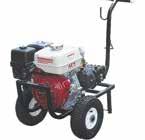








MARK DANIEL
WHILE TRACTORS, combines and machinery for agriculture and construction is still its key business, John Deere appears to be taking opportunities in the hightech sector via acquisition, with the recent purchase of Sentera, a Minnesota-based company that specialises in equipment for capturing and interpreting aerial images.
Described as being able to provide “farmers and ag service providers with a more comprehensive set of tools to generate and use data to make decisions that improve farm profitability,” Sentera may be viewed as a further piece in the smart farming jigsaw.


Interestingly, it also means that Deere might be adding drones to its portfolio, as Sentera –on top of offering sensors and cameras – has a plane-type drone within its offering, as a mounting platform for the former. The PHX drone
can fly for an hour, in which time, it can collect data over three hundred acres.
Offering the opportunity to capture more information, it is under-
stood that Sentara’s imagery capabilities, in conjunction with Deere’s digital hub, will enable farmers and advisors to seamlessly gather and integrate agronomic data,
AS IF there wasn’t enough choice in the New Zealand ute market, LDV New Zealand is expanding its offering, by showcasing the all-new Terron 9 Elite at Fieldays.
Powered by a four-cylinder, 2.5litre diesel engine, producing 163.5kW of power and 520Nm of torque, the four-wheel-drive workhorse offers a 3.5-tonne braked towing capacity to complement its smaller existing T60 line-up.
Equipped with double-wishbone suspension up front and sturdy leafspring suspension at the rear, the Terron 9 also offers a 1100kg payload capacity, with a spray-on tray
liner with four fixed tie-down points.
The 4WD workhorse is equipped with multiple terrain modes and offroad information includes altitude, compass, and approach angle, with a wading sensor to help drivers calculate the depth while driving through water.
The Elite specification also includes high-grade cloth seat covers, a six-way powered driver’s seat and a four-way manual adjustable passenger seat. Technology is abundant, with a 360-degree camera, daytime running lights, a dual 12.3-inch infotainment screen and instrument cluster and Wireless Apple CarPlay and Android
Auto connectivity. Safety is taken care of by lane keep assist, speed limit recognition and blind spot monitoring system as standard.
Kym Mellow, general manager of Inchcape New Zealand, which distributes LDV here, announced a recommended price tag of $59,990, excluding on-road costs, for the LDV Terron Elite at the annual event, commenting, “expanding our range, the TERRON 9 delivers serious toughness, intelligent capability, and highend performance, backed by LDV’s 7-year warranty, 7-year roadside assistance, and 7 years of WOF”.
– Mark Daniel
understand real-time conditions, and turn data into insights that drive decisions in the field throughout the growing season.
Key areas of assess-
ment are crop health and weed infestation, with the ability for high resolution images to be analysed to locate individual weed plants.
The resulting pre-
scription map could be used by sprayers to treat weeds though section control, or even single nozzles. It is claimed that the same process can be used in a paddock to assess crop stand uniformity, disease pressure, and pests, opening all areas to more efficient remedial action.
Rural News understands that Sentera will continue to supply cameras directly to drone manufacturers for integration into their products, as well as selling to farmers, agronomists, ag retailers, and other users.
In addition, the John Deere Operations Centre will continue to be open to other drone imagery providers, where images may be used in the Map Layers tool, enabling farmers and advisors to continue to have the choice of which solutions best suits their operation.


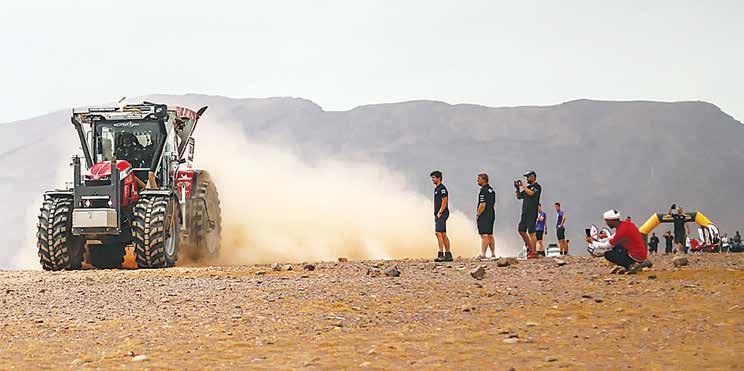
IT SEEMS that tractor manufacturers will go to great efforts to promote the versatility and durability of their offerings, a recent example being a Massey Ferguson with an 8S tractor entered into the Morocco Desert Challenge. Next to the Dakar Rally, the Moroccan event is the second largest rally raid in the world, with eight stages leading entrants into the south of the country and the Sahara Desert. The 8S was entered in the truck category and is the first tractor to enter the event.
While the standard 8S series offers a maximum output of 301hp, the event entry – powered by the 7.4l Agcopower engine, was “tweaked” to deliver 400hp, with an additional fuel tank fitted to cope with an increased thirst.
Transmission choice was the standard Dyna E-Power dualclutch unit, which MF says combines the benefits of a continuously variable transmission with the ability to transmit power as efficiently as a mechanical transmission.
The choice was driven to address the challenging terrain of sand dunes, requiring the tractor
to apply maximum power to the ground without the momentary breaks in drive typically associated with mechanical transmissions during gear or range changes.
The top speed was increased to 75km/h (47m/h) with Michelin Evobib VF 600/70 R30 tyres fitted to the front and VF 710/70 R42 at the rear, with a PTG central tyre inflation system allowing inflation pressure adjustments to suit the varying conditions.
Prepared by Swiss machinery dealer Kufferagri Sarl, additions included a full roll cage with two fully harnessed racing seats and offset controls, a spare
wheel mounted on the rear with a 180° pivoting crane, front axle suspension modification, side windows replaced with polycarbonate instead of glass and camera rearview mirrors.
The tractor completed the course in 75th place of 144 overall competitors, hitting fourth place from eight entrants in the truck category, surviving for more than 2000km of rigorous driving and more than 13 hours of continuous gear changes, proving itself a true competition-grade sequential gearbox.
@rural_news facebook.com/ruralnews
WITH AN ongoing trend towards lower agrochemical use, many companies are offering a range of mechanical weeders. Early adopters, the Kverneland Group, have taken the decision to streamline and consolidate its French factories by transferring mechanical weeding equipment production to its implement manufacturing sites at Les Landes-Genusson.
KVG- LLG will see a major expansion to strengthen its position in the cultivation and mechanical weeding machinery marketplace, filling an increasing global demand in the sector.
The expansion will double production capacity for both Kubota and Kverneland branded implements, alongside introducing larger machinery like the XL compact disc harrow, while also supporting the growing need for mechanical weeding technology as interest in sustainable farming grows. Included in the expansion, the research and development (R&D) workshop will increase to 1000m², with the production area seeing an increase in factory automation with welding and painting robots, alongside automated guided vehicles.




three different configurations.
CASE IH is expanding its popular Puma range in New Zealand, with a new model that was released at Fieldays.
The latest Puma Tier 3 long wheelbase configuration offers a refreshed model to the local market, designed for farmers looking for a reliable, no-fuss workhorse.
Removing the requirement for AdBlue, making it easier to use and maintain, also sees service intervals extended by 25% over the previous Tier 3 range, helping to reduce the cost of ownership.
Seamus McCarthy, Case IH product manager ANZ, said, “It’s a great all-rounder that delivers power and performance while keeping it simple” while noting the new Puma model came in
The entry level specification tractor features a Powershift transmission, mechanical remotes, but also offers 15% better torque and 23% more power than the previous Tier 3 Puma range. The mid-level upgrades to electric remotes, with the same Powershift transmission, while the top level offers a CVT with electric remotes, with the option of factory installed, GPS-ready configuration. The range is available in 180hp, 200hp, and 220hp variants, optional technology capabilities and loader compatibility to suit a wide range of different farming operations.
In other news, revealed at the recent CNH Investor Day 2025, product launches planned for Case IH and

with plans to completely refresh the tractor line-up
from 20-700hp+ for both brands by 2030. A recent press release has already previewed
three new Magnum 390435hp models (CVT or powershift) and fullywheeled or Rowtrac (385/405) models. CNH says 10 new combines are in the pipeline, alongside 30+ precision tech releases and 19 new sprayers, while integrating tech and iron appears to be a common link.
The company also released details of two new smart spraying solutions, with SenseApply/IntelliSense Sprayer Automation (green on brown) using multi-spectral cameras to detect plant health and weed location. AI and machine learning is said to reduce herbicide usage by around 60%. Meanwhile, herbicide usage can be reduced by up 80% with One Smart Spray (green on green), planned for a launch in 2027.








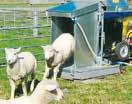















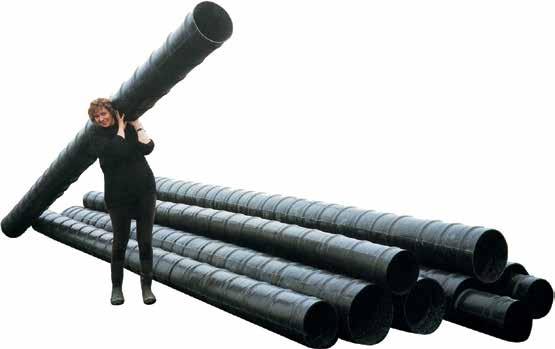

















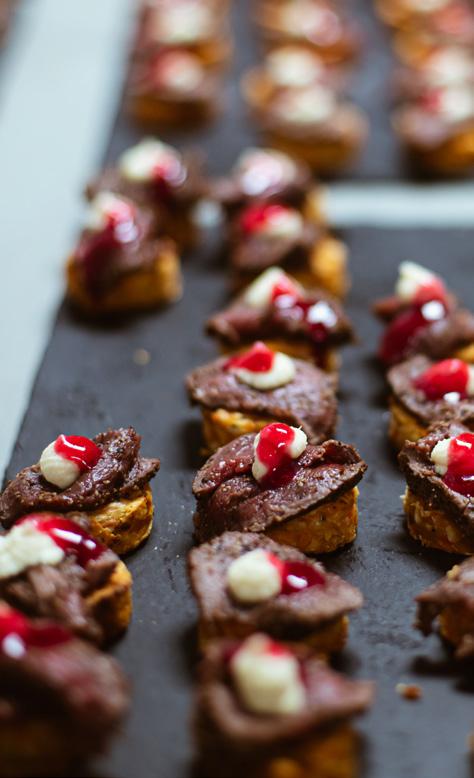
In a world where change is the only constant – shaped by unprecedented geopolitical shifts, evolving consumer expectations and a dynamic global trade environment – staying grounded and future focused has never been more important.
Our Plate to Pasture Farmer Conference is your opportunity to cut through the noise and focus on what’s really important.
We’re hosting a lineup of industry leaders and expert speakers, plus the Boning Competition National Finals, and of course the Plate to Pasture Supplier Awards.
We’re inviting everyone who creates goodness with us – farm owners, managers, stock hands and shepherds; wise old hands and keen young guns.
Our conference is free to attend for all suppliers, shareholders and teams.
